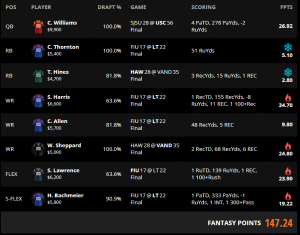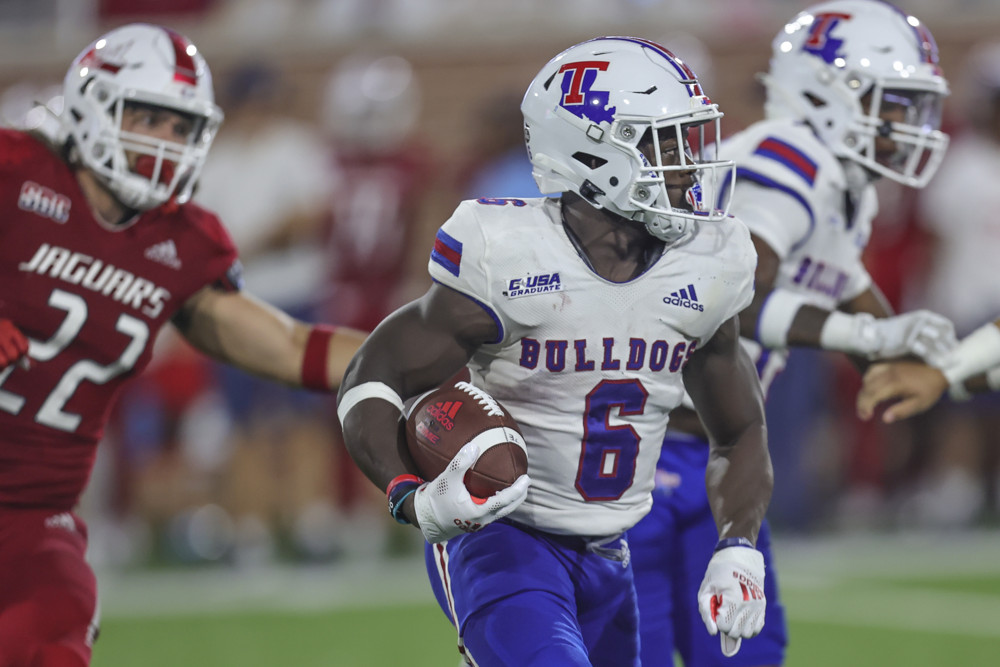Week 0 is quite different from most DraftKings CFB main slates throughout the year, and that became quickly apparent as we had a very limited pool of plays in legitimate contention for our cash-game lineups. There really were not too many decisions to be made, but let’s run through the thought process and then identify the key decision point before we touch on the results.

The slate clearly presented Caleb Williams as QB1 due to soft pricing and his relatively massive raw points projection. Hank Bachmeier ended up being the most logical QB2 due to his price tag. While I did like Rourke’s price tag as well at a few hundred savings, his matchup and health (returning from an ACL tear) concerns removed him from legitimate consideration. Really only Diego Pavia was a decision, and if the price tags were much closer, it may have been worth consideration. However, his potential ceiling was not worth the risk considering you had to sacrifice elsewhere to move from Bachmeier to Pavia.
At running back, Tylan Hines and Charvis Thornton were the two guys that came preloaded into the lineup — mostly just due to expected role versus price tag. While Thornton’s role did have some concerns, it was evident that at the very least he was likely to have a 60%+ snap share on a good offense, in a great spot. Once Tyre Shelton was ruled out, Thornton was an absolute lock in cash. He looked great early before getting injured after five carries, so it was just a bad runout. We were assuming that Hines would have a better role than last season, which really did not pan out at all. He only played 28 of 62 offensive snaps and was highly inefficient when he did touch the ball. Based on all of the information we had on Hines, I don’t regret the play or think it was a poor process; we will just have to adjust our thinking about his role in the offense moving forward. Austin Jones, Shomari Lawrence, and Sieh Bangura are the other running backs that were in consideration, but none presented as a priority.
DraftKings blessed us with $5,000 Will Sheppard versus Hawaii, so he was an easy click at WR. Beyond that, Smoke Harris was the priority play for us due to his extremely high floor and a large volume of short targets in what we thought would be a pass-happy offense. Smoke happened to break a long touchdown and hit his ceiling, which was certainly helpful from a results perspective. Dorian Singer, Cyrus Allen, Sam Wiglusz, Tru Edwards, and Charles Ross were all on my radar for the third spot and potentially playing another in FLEX. If we knew the Jacoby Jones news ahead of the slate, I likely would have explored more options with using him.
After clicking in the core of six plays (Caleb, Bachmeier, Hines, Thornton, Sheppard, and Smoke), we had a rather small pool of second-tier plays that felt somewhat comfortable. Ultimately, it came down to a 2v2 for me, which consisted of Dorian Singer and Charles Ross versus Shomari Lawrence and Cyrus Allen. Our consistent take all week was that it’s very challenging to peg USC skill players outside of Caleb Williams due to expected rotation, but there was no denying Singer’s big-play ability. Charles Ross seemed like a fine play considering we thought it was quite possible that Justin Lockhart would sit out, so the assumption would have been an increased target share. We thought Louisiana Tech could likely throw more due to running back injuries, and felt very confident Cyrus Allen would have a full-time role. Lawrence was a little bit more risky not knowing how their running back rotation would go, but the matchup versus the La Tech rush defense was prime. In the end, it came down to being too concerned with USC spreading the ball around, so I went with the Allen and Lawrence side, which ended up being the better side by 8.4 points on the back of Lawrence’s 23.9 fantasy-point performance. We ran good there.
Week 0 Results
For comparison purposes, we will be taking a look at how the lineup fares in the largest-field single-entry double-up, as that will give us the best sample to judge the lineup. Due to this being a five-game slate with several clear plays, this lineup ended up being part of a massive 95-lineup train that safely landed above the cash line. Week 0 always has some gross games with limited options for those of us trying to turn $5 into $9, but I think all things considered we had a solid thought process and enjoyed favorable results. We booked the W, and now on to Week 1!



